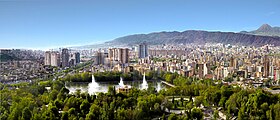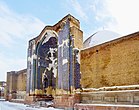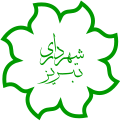
Back Tabris Afrikaans Täbris ALS تبريز Arabic تبريز ARZ Tabriz AST Təbriz Azerbaijani تبریز AZB Тәбриз Bashkir Тэбрыз Byelorussian Тэбрыз BE-X-OLD
This article needs additional citations for verification. (March 2024) |
Tabriz
Persian: تبریز | |
|---|---|
City | |
From top to bottom & from left to right: Skyline of the city, Tabriz Municipality Palace, El-Gölü, Arg of Tabriz, Blue Mosque, Bazaar of Tabriz, and Mausoleum of Poets. | |
| Nickname: | |
| Coordinates: 38°04′53″N 46°18′02″E / 38.08139°N 46.30056°E[1] | |
| Country | Iran |
| Region | 3 |
| Province | East Azerbaijan |
| County | Tabriz |
| District | Central |
| Government | |
| • Mayor | Yaghoub Houshyar |
| • Chairman of City Council | Rasoul Bargi |
| • Parliament | Alirezabeighi, Saei, Farhanghi, Bimegdar, Pezeshkian & Saeidi |
| Area | |
| • City | 325 km2 (125 sq mi) |
| • Urban | 512 km2 (198 sq mi) |
| • Metro | 1,500 km2 (600 sq mi) |
| Elevation | 1,351.4 m (4,433.7 ft) |
| Population (2016) | |
| • Urban | 1,558,693[3] |
| • Metro | 1,773,023[2] |
| • Rank | 6th in Iran |
| Demonyms | Tabrizian, Tabrizli, Tabrizi |
| Time zone | UTC+3:30 (IRST) |
| Postal code | 51368 |
| Area code | 041 |
| Website | Tabriz municipality |
Tabriz (Persian: تبریز; pronounced [tæbˈɾiːz] ⓘ)[a] is a city in the Central District of Tabriz County, in the East Azerbaijan province of northwestern Iran. It is the sixth-most-populous city in Iran.
Tabriz is in the Quru River valley in Iran's historic Azerbaijan region[4] between long ridges of volcanic cones in the Sahand and Eynali mountains. Tabriz's elevation ranges between 1,350 and 1,600 m (4,430 and 5,250 ft) above sea level. The valley opens up into a plain that gently slopes down to the eastern shores of Lake Urmia, 60 km (37 mi) to the west. The city was named World Carpet Weaving City by the World Crafts Council in October 2015[5] and Exemplary Tourist City of 2018 by the Organisation of Islamic Cooperation.[6][7]
With a population of over 1.7 million (2016),[8] Tabriz is the largest economic hub and metropolitan area in northwest Iran. The population is bilingual with most people speaking Azerbaijani as their native language and Persian as their second language.[9] Tabriz is a major heavy industries hub for automobiles, machine tools, refineries, petrochemicals, textiles and cement production industries.[10] The city is famous for its handicrafts, including hand-woven rugs and jewelry. Local confectionery, chocolate, dried nuts and traditional Tabrizi food are recognized throughout Iran as some of the best. Some of the most esteemed cultural institutions in northwest Iran are located in Tabriz, which is also a center for intellectual activity.
Tabriz contains many historical monuments, representing Iran's architectural transition throughout its long history. Most of Tabriz's preserved historical sites belong to Ilkhanid, Safavid and Qajar.[11][12] Among these sites is the grand Bazaar of Tabriz, which is designated a World Heritage Site.[13][14] From the early modern era, Tabriz was pivotal in the development, movement and economy of its three neighboring regions; namely the Caucasus, Eastern Anatolia and Central Iran.[15] In the modern era the city played a vital role in the history of Iran. As the country's closest hub to Europe, many aspects of early modernization in Iran began in Tabriz.[15] Prior to forced ceding of the Qajar dynasty's Caucasian territories to Imperial Russia, following two Russo-Persian Wars in the first half of the 19th century, Tabriz was at the forefront of Iranian rule over its Caucasian territories. Until 1925, the city was the traditional residence of the Qajar crown princes.
- ^ OpenStreetMap contributors (5 April 2023). "Tabriz, Tabriz County" (Map). OpenStreetMap. Retrieved 5 April 2023.
- ^ "Major Agglomerations of the World - Population Statistics and Maps". citypopulation.de. 13 September 2018. Archived from the original on 13 September 2018.
- ^ Cite error: The named reference
2016 censuswas invoked but never defined (see the help page). - ^ "AZERBAIJAN". Encyclopaedia Iranica, Vol. III, Fasc. 2–3. 1987. pp. 205–257. Archived from the original on 23 January 2013. Retrieved 13 January 2019.
- ^ "Celebration of the 'World Carpet Weaving City' on 6 Oct, 2015, in Tabriz, Iran". World Crafts Council Asia Pacific region. Archived from the original on 19 September 2020. Retrieved 25 May 2017.
- ^ "Tabriz named as exemplary tourism city for 2018". realiran. 24 December 2015. Archived from the original on 21 October 2020. Retrieved 9 July 2016.
- ^ "Tabriz selected OIC City of Tourism for 2018". IRNA. 24 December 2015. Archived from the original on 22 August 2016. Retrieved 9 July 2016.
- ^ "نتايج سرشماري – جمعيت و خانوار به ترتيب استان، شهرستان". Statistical Center of Iran. Archived from the original on 14 March 2017. Retrieved 16 March 2017.
- ^ "2011 Census – Natayej" (PDF). Iran: Statistical Centre. Archived from the original (PDF) on 3 July 2014. Retrieved 27 February 2008.
- ^ "Results of national 2007 census". Statistical Center of Iran. Archived from the original on 25 July 2013. Retrieved 11 February 2013.
- ^ "East Azerbaijan Geography". Editorial Board. Iranian Ministry of Education. 2000. Archived from the original on 10 January 2012.
- ^ "de beste bron van informatie over tabrizcity. Deze website is te koop!". tabrizcity.org. Archived from the original on 16 February 2007. Retrieved 2 April 2012.
- ^ "Tabriz Historic Bazaar Complex". UNESCO World Heritage Centre. UNESCO. 31 July 2010. Archived from the original on 6 July 2018. Retrieved 2 April 2012.
- ^ Assari, Ali; Mahesh, T. M. (December 2011). "Compatitive Sustainability of bazaar in Iranian traditional cities: Case Studies in Isfahan and Tabriz" (PDF). International Journal on Technical and Physical Problems of Engineering. 3 (9): 18–24. Archived (PDF) from the original on 22 December 2018. Retrieved 7 January 2013.
- ^ a b electricpulp.com. "TABRIZ v. The city in the 19th century". Encyclopaedia Iranica. Archived from the original on 25 October 2020. Retrieved 25 May 2015.
Cite error: There are <ref group=lower-alpha> tags or {{efn}} templates on this page, but the references will not show without a {{reflist|group=lower-alpha}} template or {{notelist}} template (see the help page).
© MMXXIII Rich X Search. We shall prevail. All rights reserved. Rich X Search








